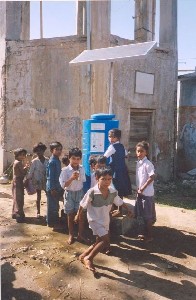
Developing nations go solar
UK-based solar company G24 Innovations this month started production of a low-cost, non silicon-based solar panel, which it says it will make available to developing countries from next year.
The sun supplies only a tiny fraction — less than one tenth of 1 percent — of mankind’s energy needs, yet the growing need to move away from traditional fossil fuels, because of rising oil prices and environmental concerns, has sparked a surge of investment in solar power.
This trend is bringing down the costs of the alternative energy source, but affordability problems still dog hopes for the 1.6 billion people, globally, without electricity and the further two to three billion people with access only to primitive energy sources
This is particularly apparent in India, where 60 percent of households, particularly in rural areas, are off-grid. These communities are dependent on kerosene, or paraffin, lamps for lighting and cooking, the use of which creates indoor pollution which, worldwide, causes about 1.5 million deaths annually.
In spite of efforts by private firms, backed by Indian state government subsidies, to push solar power as a clean and efficient energy alternative, uptake has been slow. This has mainly been due to the cost.
“Where a standard solar panel, replacing three smoky paraffin lamps, costs $250, this can be equal to at least 12 months’ income for many rural households” says the Solar Electric Light Company director Harish Hande.
This pattern is also repeated in Africa and across the developing world though, fortunately, this seems likely to change with the cost of solar power set to fall.
That’s where G24 Innovations comes into the story. Their claims of a low-cost, non silicon-based solar panel have yet to be proven, but are a promising sign.
The use of G24i’s technology permits the use of many electric-powered devices in locations where there is not yet a reliable source of electricity.
The inexpensive solar cells in conjunction with government subsidies will make energy self sufficiency a more affordable prospect and will likely be used by off-grid people to charge essential appliances that don’t use a lot of power including items such as radios, mobile phones, water purifiers and bright, efficient lamps called light emitting diodes (LEDs).
This innovation has come about as the result of The World Bank last month announcing a private sector competition to devise the best-value, low carbon light source for poor households in developing countries, as a way to flag up what it estimates is a $17 billion market in off-grid lighting in Africa alone.
In addition, rapidly developing countries like China are joining a silicon solar cell manufacturing boom, helping to pare the price of the alternative technology with the production of simple, economy panels which could soon be affordable to the rural poor, bringing clean cheap energy to those who need it most.
2 Responses
A great need for solar energy is amongst poor Roma families in Romania who cannot afford the price of privatized grid electricity. their needs are for a light and recharding cell phones, perhaps to run a laptop computer, not more.
I just wanted to know if i can buy the solar pannels now.
Samson Macha